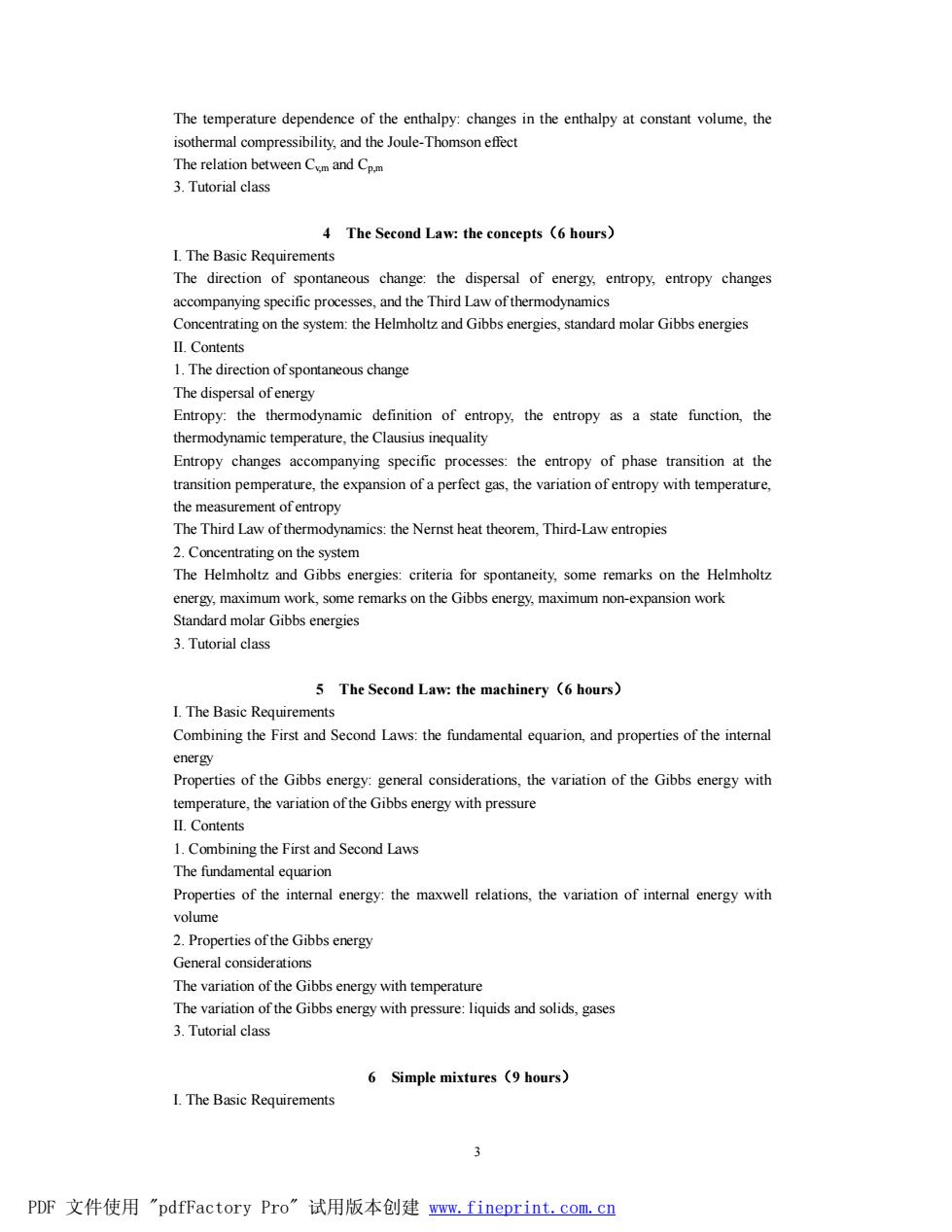正在加载图片...

The temperature dependence of the enthalpy:changes in the enthalpy at constant volume,the isothermal compressibility.and the Joule-Thomsoneffec The relation between Cm and Cm 3.Tutorial class 4 The Second Law:the concepts (6 hours) I.The Basic Requirements The direction of spontaneous change:the dispersal of energy,entropy,entropy changes accompanying specific processes,and the Third Law ofthermodynamics Concentrating on the system:the Helmholtz and Gibbs energies,standard molar Gibbs energies IL Contents The dispersal of energy Entropy:the thermodynamic definition of entropy,the entropy as a state function,the thermodynamic temperature.the Clausius inequality Entropy changes accompanying specific processes:the entropy of phase transition at the ransition pemperature,the n of a perfect gas,the variatio of entropy with temperature the mea asurement of entropy The Third Law ofthermodynamics:the Nernst heat theorem,Third-Law entropies 2.Concentrating on the system The Helmholtz and Gibbs energies:criteria for spontaneity,some remarks on the Helmholtz energy.maximum work,some remarks on the Gibbs energy.maximum non-expansion work dard molar Gibbs energie 3.Tutorial clas 5 The Second Law:the machinery (6 hours) I.The Basic Requirements Combining the First and Second Laws:the fundamental equarion,and properties of the interal energy Properties of the Gibbs energy:general considerations,the variation of the Gibbs energy with temperature,the variation of the Gibbs energy with pressure II.Contents 1.Combining the First and Second Laws The fundan Properties of the interal energy:the maxwell relations,the variation of interal energy with volume 2.Properties of the Gibbs energy General considerations The variation of the Gibbs temper ure ofthe Gibbs energy with pressure:liquids and solids,gases 3.Tutorial class 6 Simple mixtures (9 hours) 1.The Basic Requirements 3 PDF文件使用"pdfFactory Pro”试用版本创建ww,fineprint.com,cn3 The temperature dependence of the enthalpy: changes in the enthalpy at constant volume, the isothermal compressibility, and the Joule-Thomson effect The relation between Cv,m and Cp,m 3. Tutorial class 4 The Second Law: the concepts(6 hours) I. The Basic Requirements The direction of spontaneous change: the dispersal of energy, entropy, entropy changes accompanying specific processes, and the Third Law of thermodynamics Concentrating on the system: the Helmholtz and Gibbs energies, standard molar Gibbs energies II. Contents 1. The direction of spontaneous change The dispersal of energy Entropy: the thermodynamic definition of entropy, the entropy as a state function, the thermodynamic temperature, the Clausius inequality Entropy changes accompanying specific processes: the entropy of phase transition at the transition pemperature, the expansion of a perfect gas, the variation of entropy with temperature, the measurement of entropy The Third Law of thermodynamics: the Nernst heat theorem, Third-Law entropies 2. Concentrating on the system The Helmholtz and Gibbs energies: criteria for spontaneity, some remarks on the Helmholtz energy, maximum work, some remarks on the Gibbs energy, maximum non-expansion work Standard molar Gibbs energies 3. Tutorial class 5 The Second Law: the machinery(6 hours) I. The Basic Requirements Combining the First and Second Laws: the fundamental equarion, and properties of the internal energy Properties of the Gibbs energy: general considerations, the variation of the Gibbs energy with temperature, the variation of the Gibbs energy with pressure II. Contents 1. Combining the First and Second Laws The fundamental equarion Properties of the internal energy: the maxwell relations, the variation of internal energy with volume 2. Properties of the Gibbs energy General considerations The variation of the Gibbs energy with temperature The variation of the Gibbs energy with pressure: liquids and solids, gases 3. Tutorial class 6 Simple mixtures(9 hours) I. The Basic Requirements PDF 文件使用 "pdfFactory Pro" 试用版本创建 www.fineprint.com.cn